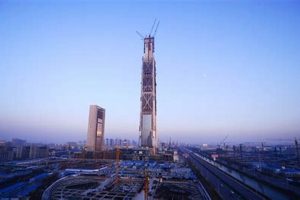The term “America’s first skyscraper” refers to the Home Insurance Building in Chicago, Illinois, constructed in 18841885. The ten-story, 138-foot-tall building was designed by architect William Le Baron Jenney and is considered the first skyscraper because it employed a steel-frame construction method that allowed for greater height and more efficient use of space.
The Home Insurance Building was a significant architectural achievement and helped to usher in the era of modern skyscrapers. It demonstrated the potential of steel-frame construction and paved the way for the construction of even taller buildings. The building’s design also included other innovative features, such as large windows to maximize natural light and a central elevator to facilitate movement between floors.
The Home Insurance Building was demolished in 1931, but its legacy continues to this day. The building’s innovative design and construction methods influenced the development of modern skyscrapers, and its status as America’s first skyscraper remains a testament to the ingenuity and ambition of American architects and engineers.
1. Steel frame
The use of a steel frame was a key factor in the Home Insurance Building’s designation as America’s first skyscraper. Prior to the development of steel-frame construction, buildings were limited in height due to the weight and strength of the materials used. Wood and cast iron, the primary building materials of the time, were not strong enough to support buildings that were more than a few stories tall.
The steel frame allowed the Home Insurance Building to be built to a height of ten stories, which was significantly taller than any other building at the time. The steel frame also made the building lighter, which reduced the on the foundation and allowed for a more efficient use of space.
The Home Insurance Building’s steel-frame construction was a revolutionary development in architecture and engineering. It paved the way for the construction of even taller and more impressive skyscrapers, and it remains an important part of the history of American architecture.
2. Elevator
The installation of an elevator in the Home Insurance Building was a significant development in the history of skyscrapers. Prior to the invention of the elevator, buildings were limited in height due to the difficulty of accessing the upper floors. Stairs were the only means of reaching the upper floors, which made it difficult for people to work and live in tall buildings.
- Increased height: The elevator made it possible to build taller buildings. Prior to the invention of the elevator, buildings were typically only a few stories tall. The Home Insurance Building, with its ten stories, was significantly taller than any other building at the time.
- Improved accessibility: The elevator made it easier for people to reach the upper floors of buildings. This was especially important for businesses, which could now locate their offices on higher floors to take advantage of natural light and views.
- Increased density: The elevator allowed for a more efficient use of space in buildings. By making it possible to reach the upper floors of buildings, the elevator allowed for more people to work and live in a single building.
- Changed the way people lived and worked: The elevator had a significant impact on the way people lived and worked. Prior to the invention of the elevator, most people lived and worked in low-rise buildings. The elevator made it possible for people to live and work in taller buildings, which led to the development of more densely populated urban areas.
The invention of the elevator was a key factor in the development of skyscrapers. It made it possible to build taller buildings, which allowed for a more efficient use of space and improved accessibility. The elevator also had a significant impact on the way people lived and worked, and it remains an essential part of modern skyscrapers.
3. Fireproofing
The fireproofing of the Home Insurance Building was a key factor in its designation as America’s first skyscraper. Prior to the development of fireproofing techniques, buildings were at great risk of being destroyed by fire. Fires were a common occurrence in cities, and they could quickly spread from one building to another.
- Reduced fire risk: The fireproofing of the Home Insurance Building significantly reduced the risk of fire. The use of brick, tile, and metal in the building’s construction made it resistant to fire, and it was able to withstand several fires throughout its history.
- Increased safety: The fireproofing of the Home Insurance Building made it a safer place to work and live. People could be confident that the building would not be destroyed by fire, and they could feel safe inside the building.
- Allowed for taller buildings: The fireproofing of the Home Insurance Building made it possible to build taller buildings. Prior to the development of fireproofing techniques, buildings were limited in height due to the risk of fire. The Home Insurance Building, with its ten stories, was significantly taller than any other building at the time.
The fireproofing of the Home Insurance Building was a major advancement in architecture and engineering. It made it possible to build taller and safer buildings, and it paved the way for the development of modern skyscrapers.
4. Windows
The use of large windows in the Home Insurance Building was a significant improvement over previous buildings, which were often dark and cramped. This had a number of important implications for the building’s occupants and the development of skyscrapers in general.
- Improved working conditions: The large windows allowed for natural light to enter the building, which created a more pleasant and productive working environment. This was especially important for the building’s office workers, who spent long hours working at their desks.
- Reduced health risks: The natural light from the windows helped to reduce the risk of health problems for the building’s occupants. This is because natural light has been shown to improve mood, boost energy levels, and reduce the risk of eye strain.
- Increased aesthetic appeal: The large windows gave the Home Insurance Building a mo
re attractive appearance. This was important for a building that was intended to be a symbol of American ingenuity and progress. - Set a precedent for future skyscrapers: The Home Insurance Building’s use of large windows set a precedent for future skyscrapers. Many of the skyscrapers that were built in the following decades also featured large windows, which helped to create more livable and productive work environments.
In conclusion, the use of large windows in the Home Insurance Building was a significant improvement over previous buildings. This had a number of important implications for the building’s occupants and the development of skyscrapers in general.
5. Location
The location of the Home Insurance Building in the heart of Chicago’s business district was a key factor in its success as America’s first skyscraper. The building was close to major transportation hubs, making it easy for businesses to move their employees and goods in and out of the building. It was also close to other businesses and services, making it convenient for employees to run errands and conduct business.
The building’s location also helped to attract tenants. Businesses were willing to pay a premium to be located in a prestigious building in a convenient location. This allowed the Home Insurance Building to charge higher rents, which helped to offset the cost of construction and maintenance.
The Home Insurance Building’s location also had a positive impact on the development of the surrounding area. The building’s presence helped to attract other businesses to the area, which created a more vibrant and prosperous business district.
In conclusion, the location of the Home Insurance Building in the heart of Chicago’s business district was a key factor in its success as America’s first skyscraper. The building’s location made it convenient for businesses to locate their offices in the building, which helped to attract tenants and generate revenue. The building’s location also had a positive impact on the development of the surrounding area.
6. Height
The height of the Home Insurance Building was a key factor in its designation as America’s first skyscraper. Prior to the construction of the Home Insurance Building, no building had ever been built to a height of ten stories. The building’s height was a testament to the ingenuity and engineering prowess of American architects and engineers.
- Symbol of American ingenuity and progress: The Home Insurance Building was a symbol of American ingenuity and progress. The building’s height and innovative design demonstrated the capabilities of American architects and engineers. It was a source of pride for Americans and a reminder of the country’s growing economic and technological power.
- Inspired the construction of other skyscrapers: The Home Insurance Building inspired the construction of other skyscrapers in Chicago and around the world. It showed that it was possible to build tall buildings that were safe and functional. The Home Insurance Building helped to usher in the era of skyscraper construction.
- Changed the way people thought about buildings: The Home Insurance Building changed the way people thought about buildings. Prior to the construction of the Home Insurance Building, most people lived and worked in low-rise buildings. The Home Insurance Building showed that it was possible to live and work in tall buildings, and it helped to make skyscrapers a more common sight in cities around the world.
The height of the Home Insurance Building was a major factor in its success as America’s first skyscraper. The building’s height was a symbol of American ingenuity and progress, and it inspired the construction of other skyscrapers around the world. The Home Insurance Building changed the way people thought about buildings, and it helped to make skyscrapers a more common sight in cities around the world.
7. Legacy
The Home Insurance Building was demolished in 1931, but its legacy continues to this day. The building’s innovative design and construction methods influenced the development of modern skyscrapers, and its status as America’s first skyscraper remains a testament to the ingenuity and ambition of American architects and engineers.
- Influence on modern skyscrapers: The Home Insurance Building’s innovative design and construction methods influenced the development of modern skyscrapers. The building’s use of a steel frame, elevators, and fireproofing techniques set a precedent for future skyscrapers. Many of the skyscrapers that were built in the following decades incorporated these same features.
- Symbol of American ingenuity and ambition: The Home Insurance Building was a symbol of American ingenuity and ambition. The building’s height and innovative design demonstrated the capabilities of American architects and engineers. It was a source of pride for Americans and a reminder of the country’s growing economic and technological power.
- Landmark in architectural history: The Home Insurance Building was a landmark in architectural history. It was the first building to be designated as a skyscraper, and it helped to usher in the era of skyscraper construction. The building’s design and construction methods were studied by architects and engineers around the world.
- Inspiration for future architects and engineers: The Home Insurance Building continues to inspire architects and engineers today. The building’s innovative design and construction methods are a reminder of the possibilities of architecture and engineering. The building’s legacy is a source of inspiration for future generations of architects and engineers.
The Home Insurance Building may be gone, but its legacy continues to this day. The building’s innovative design and construction methods influenced the development of modern skyscrapers, and its status as America’s first skyscraper remains a testament to the ingenuity and ambition of American architects and engineers.
FAQs about America’s First Skyscraper
This section addresses frequently asked questions and clears up common misconceptions about America’s first skyscraper, providing a deeper understanding of its significance and impact.
Question 1: What is considered America’s first skyscraper and why?
The Home Insurance Building in Chicago, completed in 1885, holds the distinction as America’s first skyscraper. Its innovative use of a steel-frame construction method allowed for greater height and efficient use of space, setting it apart from previous buildings constructed primarily of wood or cast iron.
Question 2: How did the Home Insurance Building’s design influence modern skyscraper construction?
The Home Insurance Building pioneered several architectural advancements that became standard features in skyscraper construction. Its steel-frame structure provided greater strength and stability, while the incorporation of elevators and fireproofing measures enhanced safety and accessibility. These elements became essential in the design of subsequent skyscrapers, enabling t
he construction of even taller and more functional buildings.
Question 3: What was the significance of the Home Insurance Building’s location?
The building’s strategic location in the heart of Chicago’s business district played a crucial role in its success. Its proximity to major transportation hubs and other businesses made it an attractive destination for tenants, contributing to its financial viability and solidifying its status as a landmark in the city’s commercial center.
Question 4: How did the Home Insurance Building impact the surrounding area?
The presence of the Home Insurance Building had a significant impact on its surroundings. It acted as a catalyst for the development of the area, attracting businesses and services, leading to increased economic activity and the creation of a vibrant business district. The building’s architectural grandeur also influenced the design of neighboring structures, contributing to the overall aesthetic of the area.
Question 5: Why was the Home Insurance Building demolished, despite its historical significance?
Despite its architectural and historical value, the Home Insurance Building was demolished in 1931. This decision was primarily driven by economic factors. The building’s outdated design and inefficient use of space made it less desirable to potential tenants. Additionally, the construction of newer and more modern skyscrapers reduced the demand for older buildings, leading to the Home Insurance Building’s eventual demolition.
Question 6: What is the legacy of America’s first skyscraper?
The Home Insurance Building’s legacy extends beyond its physical existence. It serves as a testament to the ingenuity and ambition of American architects and engineers during the late 19th century. The building’s innovative design and construction methods laid the foundation for the development of modern skyscrapers, shaping the skylines of cities worldwide. Its historical significance continues to inspire architects and engineers, influencing the design and construction of contemporary high-rise structures.
These FAQs provide a comprehensive understanding of America’s first skyscraper, highlighting its architectural advancements, historical context, and lasting impact on the field of architecture and urban development.
Transition to the next article section:Conclusion
Tips for Understanding America’s First Skyscraper
To delve deeper into the significance and impact of America’s first skyscraper, consider these insightful tips:
Tip 1: Examine the Architectural Innovations
Analyze the innovative use of steel-frame construction, elevators, and fireproofing techniques that set the Home Insurance Building apart from its predecessors. Understand how these advancements enabled the construction of taller and more functional buildings.
Tip 2: Explore the Historical Context
Place the construction of the Home Insurance Building within the context of Chicago’s rapid growth and the technological advancements of the late 19th century. This will provide a richer understanding of the factors that led to its creation.
Tip 3: Study the Building’s Impact on the City
Examine how the Home Insurance Building influenced the development of Chicago’s business district and the city’s overall skyline. Trace its role in attracting businesses and services, and shaping the economic and architectural landscape of the area.
Tip 4: Analyze the Building’s Legacy
Assess the lasting impact of the Home Insurance Building on architecture and engineering. Consider how its design and construction methods influenced the development of modern skyscrapers and continue to inspire contemporary architects and engineers.
Tip 5: Visit the Site of the Home Insurance Building
If possible, visit the site where the Home Insurance Building once stood. Reflect on its historical significance and the legacy it left behind. Imagine the building’s presence and its role in shaping the city’s identity.
Tip 6: Explore Related Architectural Landmarks
Expand your understanding by visiting other architectural landmarks in Chicago or other cities that were influenced by the Home Insurance Building. This will provide a broader perspective on the development of skyscraper architecture.
Tip 7: Consult Historical Resources
Refer to books, articles, and online resources to delve deeper into the history and significance of the Home Insurance Building. Engage with scholarly research and diverse perspectives to enrich your understanding.
By following these tips, you will gain a comprehensive understanding of America’s first skyscraper, its historical context, architectural advancements, and lasting legacy. This knowledge will enhance your appreciation for the ingenuity and ambition that shaped the built environment of our cities.
Transition to the article’s conclusion:Conclusion
Conclusion
The exploration of America’s first skyscraper, the Home Insurance Building, unveils a pivotal chapter in architectural history. Its innovative design, employing a steel frame, elevators, and fireproofing techniques, revolutionized the construction of tall buildings, paving the way for the modern skyscrapers that grace our skylines today.
Beyond its structural advancements, the Home Insurance Building played a significant role in shaping the urban landscape of Chicago and beyond. Its presence fostered economic growth and influenced the architectural development of its surroundings. Today, its legacy continues to inspire architects and engineers, underscoring the enduring impact of this pioneering structure.
The story of America’s first skyscraper is a testament to human ingenuity and the relentless pursuit of progress. It invites us to reflect on the transformative power of architecture and its ability to shape our cities and lives. As we look towards the future of skyscraper design, the lessons learned from the Home Insurance Building will undoubtedly continue to inform and inspire generations to come.







